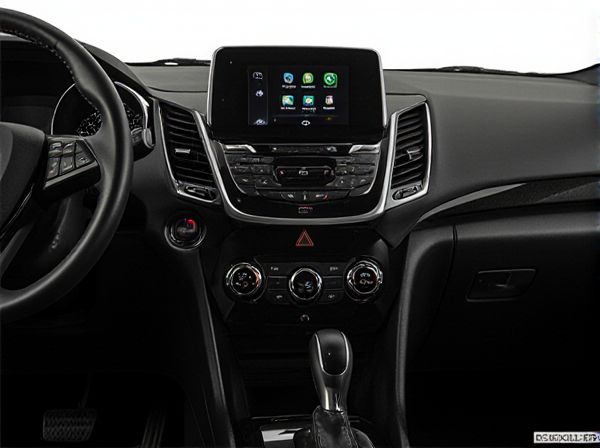
Photo illustration: Steering Wheel Integrated Controls vs Dashboard Integrated Controls
Steering wheel integrated controls offer you quick and safe access to essential functions like audio adjustments and cruise control without taking your hands off the wheel, enhancing driving focus and convenience. Dashboard integrated controls provide a centralized interface with more comprehensive options for vehicle settings and infotainment management, which can be easily viewed but may require taking your eyes off the road. Choosing between these control layouts depends on your preference for immediate tactile access versus a broader, more detailed control panel.
Table of Comparison
| Feature | Steering Wheel Integrated Controls | Dashboard Integrated Controls |
|---|---|---|
| Location | On the steering wheel for easy thumb access | Fixed on the dashboard within reach of driver |
| Safety | Enhances safety by minimizing driver distraction | May cause longer eyes-off-road time |
| Control Types | Audio, phone, cruise control, voice commands | Climate, navigation, infotainment, vehicle settings |
| Ease of Use | Highly accessible during driving | Requires reaching and visual focus |
| Customization | Limited due to space constraints | More flexible with larger interface options |
| Ergonomics | Designed for frequent use and minimal hand movement | Supports complex interactions but less ergonomic |
| Technology Integration | Often includes haptic feedback and multi-function buttons | Supports touchscreens and extensive controls |
Overview of Integrated Control Systems
Steering wheel integrated controls provide drivers with direct access to essential functions such as audio, cruise control, and phone connectivity without removing their hands from the wheel, enhancing safety and convenience. Dashboard integrated controls, positioned centrally, offer a comprehensive interface for vehicle settings, climate control, and infotainment systems, allowing for detailed adjustments and visual feedback. Both systems complement each other by combining ease of use and functionality, optimizing driver interaction with vehicle technologies.
Evolution of Automotive Control Interfaces
Steering wheel integrated controls have revolutionized vehicle ergonomics by enabling drivers to manage audio, navigation, and communication systems without removing their hands from the wheel, enhancing safety and convenience. Dashboard integrated controls, historically the primary interface, have evolved from basic knobs and buttons to advanced touchscreens with haptic feedback, offering comprehensive access to vehicle settings and infotainment. The evolution from dashboard-centric to steering wheel-integrated controls reflects a broader trend towards increasing driver focus, minimizing distraction, and improving real-time vehicle interaction through intuitive, multifunctional interfaces.
Functionality of Steering Wheel Integrated Controls
Steering wheel integrated controls offer enhanced functionality by allowing drivers to manage audio, phone calls, and cruise control without removing their hands from the wheel, significantly improving safety and convenience. These controls provide tactile feedback with easily accessible buttons and switches, reducing distraction and promoting seamless interaction with vehicle systems. Compared to dashboard integrated controls, steering wheel buttons enable quicker adjustments and better ergonomic design tailored to driver needs.
Features of Dashboard Integrated Controls
Dashboard integrated controls centralize vehicle functions such as climate settings, audio adjustments, and navigation on a touchscreen or physical buttons directly accessible from the dashboard. These controls often include customizable displays, haptic feedback, and multi-function rotary knobs, enhancing user interaction without diverting attention from driving. Advanced dashboard systems may also integrate voice commands and gesture recognition, providing seamless control over multiple vehicle features for improved safety and convenience.
Ergonomics and Driver Accessibility
Steering wheel integrated controls enhance ergonomics by allowing drivers to access key functions like audio, cruise control, and phone without removing their hands from the wheel, reducing distraction and improving safety. Dashboard integrated controls require drivers to look away from the road and reach forward, which may increase cognitive load and physical effort, negatively impacting driver accessibility. Studies show that steering wheel controls contribute to quicker response times and minimize driver fatigue compared to traditional dashboard controls.
Safety Impacts of Control Placement
Steering wheel integrated controls enhance safety by allowing drivers to adjust settings without removing their hands or eyes from the wheel, reducing distraction and reaction times. Dashboard integrated controls require drivers to divert attention away from the road, increasing the risk of accidents due to longer visual and cognitive engagement. Ergonomic studies confirm that proximity of controls to the driver's natural grip zone significantly improves vehicle control and overall safety performance.
User Experience and Convenience
Steering wheel integrated controls offer enhanced user experience by allowing drivers to adjust settings such as audio volume, phone calls, and cruise control without taking their hands off the wheel, thereby increasing safety and convenience. In contrast, dashboard integrated controls often require drivers to divert their attention and hands away from the road, potentially causing distractions and slower response times. Ultimately, steering wheel controls provide a more intuitive and ergonomic interface, optimizing driver focus and ease of use during vehicle operation.
Technological Advancements in Control Integration
Steering wheel integrated controls leverage advanced capacitive touch and haptic feedback technologies, enabling drivers to manage audio, navigation, and communication systems without taking their hands off the wheel. In contrast, dashboard integrated controls have evolved with touchscreens featuring multi-touch capabilities and voice recognition, offering enhanced functionality through centralized, customizable interfaces. Both control systems increasingly integrate with AI-driven assistance and connectivity features, improving overall vehicle interaction and safety.
Cost and Maintenance Considerations
Steering wheel integrated controls typically involve higher initial costs and more complex maintenance due to embedded wiring and electronic components requiring specialized repair. Dashboard integrated controls usually present lower costs and simpler maintenance as they are more accessible and use standard switches or buttons. Cost efficiency favors dashboard controls for easy serviceability, while steering wheel controls may raise expenses linked to intricate electronic troubleshooting.
Future Trends in Automotive Control Design
Steering wheel integrated controls are evolving towards haptic feedback and customizable touch-sensitive surfaces, enhancing driver interaction and minimizing distraction. Dashboard integrated controls are increasingly adopting augmented reality displays and voice-activated systems to provide intuitive access without compromising aesthetics. Future automotive control design prioritizes seamless integration of multimodal inputs, enabling safer and more adaptive driving experiences.
 caratoz.com
caratoz.com